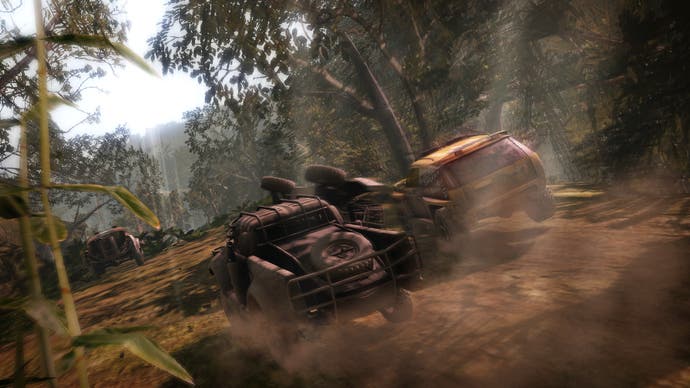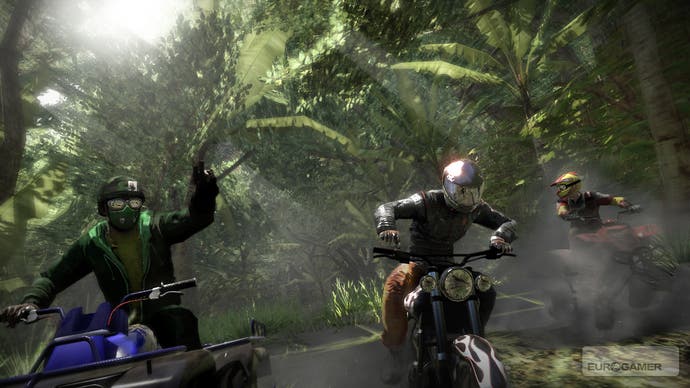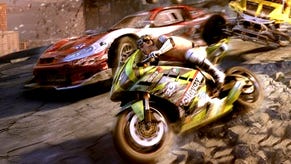MotorStorm Pacific Rift
Jungle fever.
The lengths some people will go to for a laugh. Paul Hollywood, garrulous creative director of MotorStorm Pacific Rift - you might remember him from Tom's preview - knows all about it. He put Evolution, developer of the Sony-published PS3 racing sequel, through months of painstaking work and agonising waiting just so he could relive memories of a misspent youth.
"I really, really enjoyed playing Mario Kart on the SNES," he says. Who didn't, Paul. "I lost many months of my life to it, and my friends did as well. That sort of pure arcade experience is what I'm after." But there was something missing from that goal - split-screen. The first MotorStorm's multiplayer was online only; this sequel supports up to four players on a single machine. A welcome decision, but as Hollywood reveals, it was a costly one.
"We set off down a path with the technology of MotorStorm 1 where all our rendering was single-viewport-based. Then we were like, we want to do multiple viewports, and the tech guys were like, alright, we're going to pull the engine out, we're going to strip the car down and lay all the bits on the garage floor and then we're going to rebuild it. And it's going to take a long time. And it did."

MotorStorm was out of action for so long Hollywood and his colleagues had to go back to playing the first game for reference. When Pacific Rift's rebuilt engine finally spluttered and rumbled into life some six months ago, "it was like an old friend had come back", says Hollywood. After an extensive playtest - multiple races on four tracks in three of the game's four zones - we have to agree.
MotorStorm isn't the only old friend paying us a revisit. It's interesting that Hollywood mentions Mario Kart, because Pacific Rift reminds us of recent editions of Nintendo's cartoon racer in a lot of ways: the intricate boost mechanics; the capricious, knockabout aggression of the AI racers; the sprawling, eventful, multiple-choice, tight-but-loose track design.
A revamped structure - still focused on a fictional festival of off-road racing - now breaks MotorStorm's linear progression into four, each thread focusing on one of the four themed zones of the Hawaiian setting: Fire (lava flows and volcanoes), Air (high altitude mountains), Earth (thick, muddy jungle) and Water (beaches and rivers). There's still some limiting of the vehicle classes you can use in each race as you unlock them, but it's generally less constrictive, and you can pick a favourite vehicle for each class in your garage to cut down on menu time.

When we visited, Evolution didn't have any Fire tracks available to play, but we had plenty of time with tracks from the other three zones. Kanaloa Bay (Earth) is a sprint across an open, lagoon-studded beach followed by an inland circuit of the kind of rocky, split-level terrain familiar from the first game's Monument Valley. In Cascade Falls (Water), vehicles push through a frenetic tangle of vegetation and plough through rivers and ponds before arriving at the money shot: a spectacular, sweeping banked turn under huge waterfalls.
We also try out two Air tracks. Rain God Spires takes place at an altitude of 8,000 feet, and features treacherously narrow runways over towering cliffs, and some stupendously over-the-top jumps. Meanwhile, Caldera Ridge - probably our favourite of the four - is an atmospheric pelt around the blackened summit of a volcano which threads through a ruined observatory before barrelling down a vast, wide-open slope. We also catch glimpses of Scorched - a Fire track on an active volcano, smothered in heat-haze - and Sugar Rush, a semi-indoor track weaving through a ruined sugar refinery, littered with hazards.



